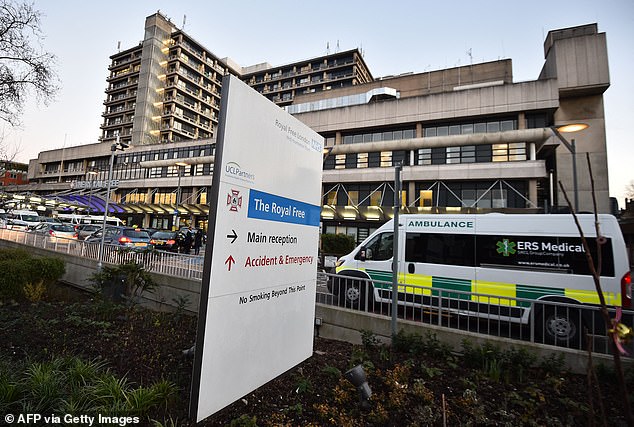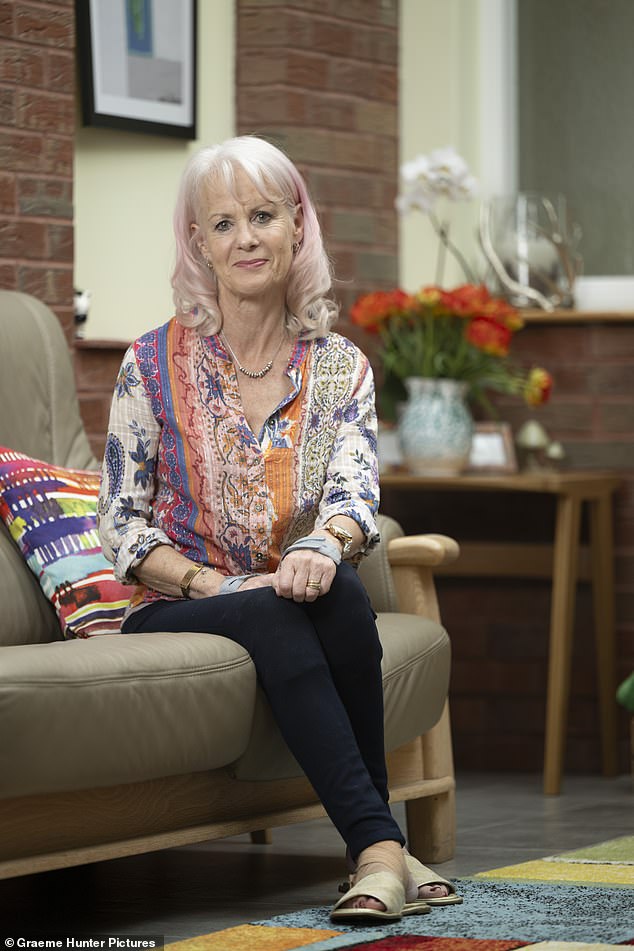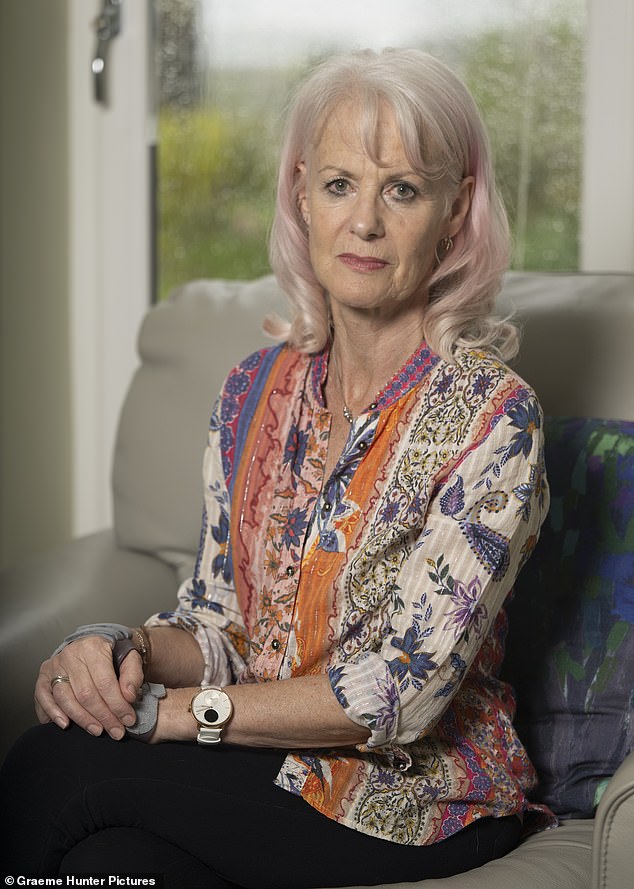By her early twenties, Maureen Sharphouse’s joints were so flexible that she landed a job as a magician’s assistant, effortlessly bending inside boxes to perform tricks on stage.
“I was literally the woman ‘sawed’ in half on stage, with my legs squeezed inside and outside my body, I was so flexible,” says Maureen, 67, a life coach who lives in Kinross-shire, Scotland, with her husband Peter, 75, a semi-retired businessman (they have five children between them from previous relationships).
‘At school I was very good at sports and dancing and could do the splits easily.’
Maureen Sharphouse, 67, suffers from Ehlers Danlos syndrome, a condition that affects one in 500 people.
But there were also some worrying health issues. “I remember my knee joint popping out several times while playing sports,” says Maureen.
There were also frequent joint pains, occasional dislocations, loss of balance and coordination, tingling and difficulty speaking.
What she couldn’t know was that these were all symptoms of a medical condition that, as she puts it, “would eventually take over my entire life.”
But it would take another 35 years until, in June 2023, he discovered what the disease was, after countless visits to countless doctors: Ehlers-Danlos syndrome.
EDS is a genetic condition that affects one in 500 people (although this figure may be an underestimate), as the varied symptoms mean it can often be overlooked or misdiagnosed.
Ehlers-Danlos syndrome affects connective tissue throughout the body, including the joints, heart, and digestive tract. There are 13 types; Maureen has many of the symptoms of hypermobility Ehlers-Danlos syndrome, the most common type, including loose, unstable joints that dislocate easily, joint pain, fatigue, digestive problems, and dizziness.
There is no test for EDS, a doctor makes a diagnosis based on symptoms and examination.
Maureen says: ‘While I was relieved to finally have the answer, I was also disappointed: why had none of the multiple doctors I had visited over 35 years connected the dots?’
Maureen’s story is far from isolated, according to Forgotten Patients, Overlooked Diseases, a charity launched in May to raise awareness of patients who are forgotten, misdiagnosed or go undiagnosed for years.
“This remains a largely ignored and under-researched area,” says Dr Adrian Tookman, co-chair of the charity and former medical director and consultant in palliative care at the Royal Free Hospital and Marie Curie Hospice in Hampstead, north London.
‘This is despite the large numbers of people believed to be affected and the huge sums of money wasted on flawed treatments and research.
‘Healthcare professionals feel frustrated at not being able to reach a diagnosis, while patients may feel lost, ignored and forgotten in the healthcare system.’
The charity’s focus is on supporting patients and helping them get a diagnosis.
“We want to find solutions, not blame doctors,” he says.
Many of these patients are classified as having “medically unexplained symptoms” (MUS) and when they are finally correctly diagnosed, they turn out to have diseases that are rare or unusual symptoms of more common diseases.
MUS is a huge problem: patients so labelled take more sick leave, have higher unemployment rates and account for 10 per cent of NHS spending on adults in England, according to a review published in BMJ Open in 2022, and one in four frequent hospital attenders is classed as having MUS.
Dr Tookman says the charity was founded after he realised that patients who came to him with complex and unexplained pain symptoms (due to his expertise in the subject), actually had undiagnosed EDS. However, they were wrongly told they had eating disorders such as bulimia.
This is because gastroparesis (or vomiting, bloating, and stomach pain) is a common sign of EDS due to its effect on the connective tissue of the digestive tract.
At a multidisciplinary meeting to discuss a patient’s case, she noticed a number of young women in the waiting room with scars on their forearms from previous suicide attempts. “I realized that these scars were elastic; in other words, there was something wrong with the collagen holding them together, and you see that in EDS.
‘I mentioned this to the psychiatrist and he told me that he had often wondered if there was an underlying physical cause for the vomiting disorders.

Dr Adrian Tookman, from the Royal Free Hospital and Marie Curie Hospice in Hampstead, north London, says huge sums are wasted due to misdiagnoses.
“Fortunately, the patient was discharged from the eating disorders unit and received treatment for her Ehlers-Danlos syndrome. We don’t know how many others have been misdiagnosed with the same condition.”
Other patients who tend to end up with a MUS label are those affected by the approximately 7,000 rare diseases (those that affect less than one in 2,000 people).
Dr Minha Rajput-Ray, a physician and osteopath who sits on the committee of the new charity, said: “It’s difficult for doctors to say, ‘I don’t really know what’s wrong with you, but let me go and find out.'”
The typical patient he sees at his Aberdeen clinic has chronic pain and fatigue conditions such as fibromyalgia, myalgic encephalomyelitis, long Covid, EDS and Lyme disease, an infection spread through an infected tick.
“These patients suffer from symptoms that no one can really understand,” says Dr. Rajput-Ray.
A patient referred to Dr. Tookman had been “for a long time” receiving a diagnosis of Klippel Trenaunay Weber syndrome, a genetic syndrome that causes enlarged legs, varicose veins and a port-wine birthmark.
“Luckily, we were able to treat her with medication to control her symptoms. No doctor I’ve spoken to had ever heard of it and that’s the problem: there are 7,000 rare diseases and some we don’t even know exist.”
“Mislabeling people is clearly dangerous,” he says.
Another problem that makes diagnosing and treating rare diseases difficult, he says, is the increase in specialization in hospital medicine over the past 20 years, meaning doctors have deep knowledge of their specialty, but not as broad a knowledge.
From her teens, Maureen suffered from intermittent joint pains that her GP attributed to “growing pains”. By her twenties, she was suffering from frequent joint dislocations and by her thirties, she began to stumble because her joints “seemed unstable”. She was prone to falls and sprains and was often covered in bruises.

EDS affects the connective tissues of the body, including the joints, heart, and digestive tract.
‘I had to go to bed and rest on Sunday afternoons because my joints hurt so much.’
In her late 40s, she also developed back pain, dizziness, nerve spasms and heart palpitations, and a rheumatologist diagnosed her with three conditions: fibromyalgia (a chronic pain disease), Raynaud’s syndrome (which affects circulation and causes cold hands and feet) and Sjogren’s syndrome (an autoimmune disease affecting parts of the body that produce fluids, such as saliva).
Her GP disagreed and sent her to a neurologist, who diagnosed her with multiple sclerosis, even though a brain scan showed no signs of it.
It was a label that stayed with her for the next 15 years.
Her poor health eventually cost her her job as a property manager and severely affected her relationship with her first husband (with whom she has two children) and her social life.
“I went through some very dark times,” she says. “I was very frustrated because no one seemed to know what was wrong with me. No doctor would listen to my full story or think beyond their specialty.”
Her symptoms intensified until 2022, when on a trip to the US for surgery she paid for to address thoracic outlet syndrome – compression of nerves and blood vessels in the chest; a doctor mentioned this was often due to a connective tissue disorder.
Upon researching this, she discovered she had EDS and her diagnosis was confirmed by a private doctor.
“He said he was sure he had gotten it within five minutes of talking to me and couldn’t understand how I had missed it.”
Although Maureen still struggles with the symptoms of Ehlers-Danlos syndrome, “getting a diagnosis made me feel validated,” she says. “It’s a shame it took almost 40 years to get to that point.”

